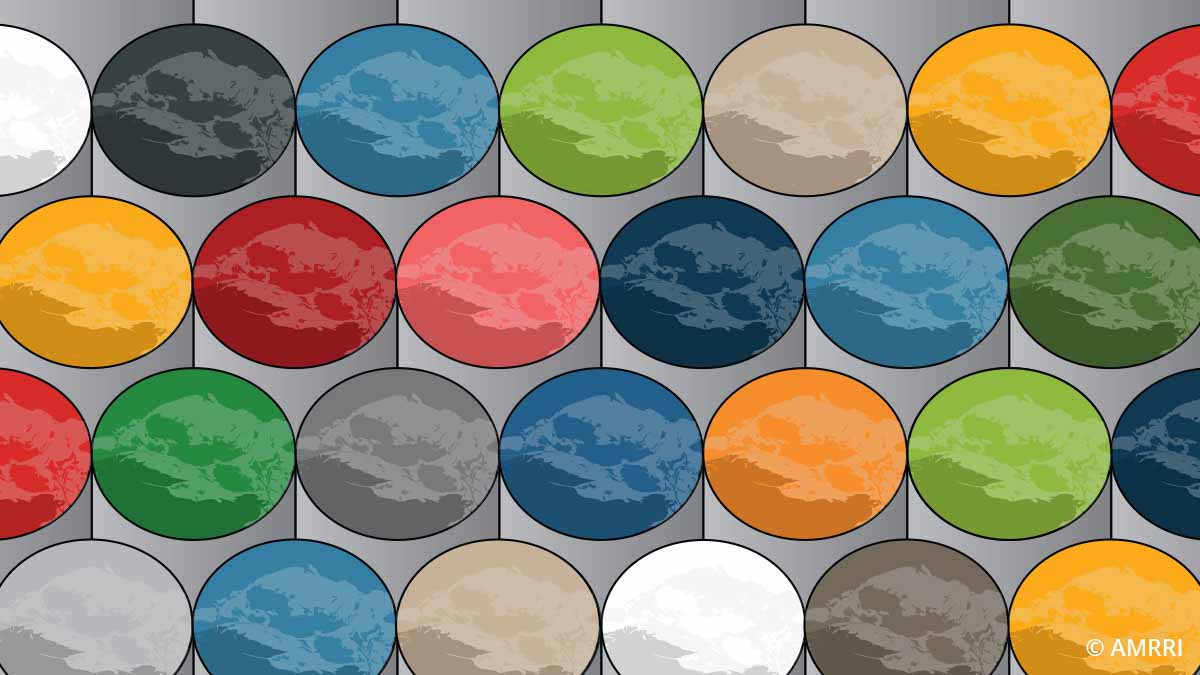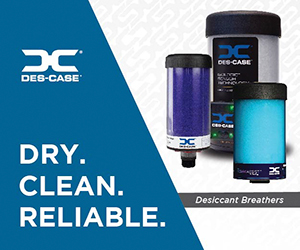I have been living in Houston, Texas, for a little over three years, and to this day, when I talk to a friend, the first sentence I hear is, “Houston, we have a problem.” It’s a trendy phrase that has become an icon for the Texan city.
However, as often happens, there is a difference with the original expression. NASA launched the Apollo 13 mission on April 11, 1970, intending to make its third moon landing. Still, due to an explosion in one of the oxygen tanks, which almost caused a disaster, astronaut Jack Swigert called the base and said, “Houston, we’ve had a problem.”
There is a big difference between having a problem and having had a problem. In industrial lubrication, this can mean the difference between minimizing the effects of the problem and assuming its consequences.
Due to the global scenario, the lubricant chain supply has many problems. From the lack of raw materials to produce additives to natural disasters, such as what happened to Afton Chemical due to heavy rains in St. Louis, which on July 26, 2022, had to declare an unplanned stoppage that may affect the additives market[1]; to a global collapse in the availability of metal drums for oils/grease where China is the world’s leading exporter, to the rise in the cost of maritime transport with increases of up to four times per container and a long list of situations that had never been seen, at least not altogether in such a short period.
In this short article, I will focus only on industrial greases due to the impact on the availability of the assets that grease can generate in the plants.
The world is feeling the effect of the current conditions, which translates for the end user into an increase in the costs of greases, low or no availability of the product, and extremely long delivery times, eight months in some countries. This has forced many users to mix greases of different brands or types.
Grease Compatibility, What Do We Know So Far?
I have had my eyes on grease analysis lab results for over a decade. Due to the complexity involved in sampling, analysis, and interpretation, it is an area with much space for study and research. I have never seen anything similar to what has been happening for over 15 months, and I speak globally.
As you can imagine, the industry has been forced to mix greases for some of the above reasons. In many cases, the mixtures have had no adverse effects on the bearings, but in others, catastrophic damage or loss of bearing service life has occurred.
In a recent study on compatibility problems between greases, out of 29 cases analyzed, 76% suffered a bearing functional failure, while 24% suffered a catastrophic failure. In 52% of these cases, the bearing had to be replaced. Some plants scheduled the replacement in less than 60 days, while a minority, close to 7%, had to wait for the bearing supplier to have it available.
Of these 29 cases, only four, 14%, conducted a compatibility analysis between greases before deciding to add the new grease to the bearing. However, the worst part of all this is that in three of these four cases, there were incompatibility problems, and two resulted in a functional failure. One of them resulted in catastrophic failure.


Unfortunately, the determination of whether the grease was compatible with another was based only on the type of thickener comparison. To complete the picture, it is necessary to say that the internet is full of grease thickener compatibility tables. In many cases, the sources are unreliable, or they are analyses carried out between the 70s and 80s, where the chemistry of these products was different from the current. Compare a couple of these tables; the result will surprise you!
You do not have to be a grease expert to know that compatibility depends on the thickener type, base oil, and the type of additives.
In addition, the ASTM D6185 standard serves as a guide to understanding the behavior of binary mixtures of greases.
However, it only partially represents what happens once the grease enters service. And, after an extensive study and developing a definition of a factor that encompasses these three grease components, I found that a global lubrication indicator (GLi) is decisive when the grease enters service in the bearing. The GLi shows how the grease lubricates.
Grease is a non-Newtonian fluid (will behave like a solid under pressure) composed:
- Oil: mineral or synthetic
- Additives: these can be dissolved in the oil or in suspension if they are solid
- Thickener: a network of material that can be soapy or non-soapy and that, in turn, can be simple or complex
They are the oil and the additives that oversee achieving the lubrication. That is the separation between the track and the rolling element through a thin film that sometimes is sacrificial. However, the three elements as a whole provide that expected quality to achieve lubrication.
The thickener acts as a sponge that retains the lubricating agents in its structure and, under mechanical stress, be it speed or load, expels these agents and then re-adsorbs them in its structure.
This intrinsic property of grease is lost over time and due to other factors specific to each operational environment. Additionally, the loss of physical properties of the grease can be due to the mixture with other(s), which results in the loss of lubrication properties and, consequently, the reduction of the service life not only of the grease but also of the bearing.
Case Study: Four of Six
In March of this year, I received one of those calls that began with, “Houston, we have a problem.” The following sentence gave clear clues to the problem “the new grease that we are using in the bearings is of an inferior quality.”
An extrusion plant had decided to replace the grease used in six bearings of one of the main lines due to the increase in price and lack of availability of the one they had in service. Both greases had a lithium-based thickener, and based on the information on the internet, it was concluded they were compatible.
After a few weeks, one bearing suffered a catastrophic failure, and in the weekly rounds, the site found that three others had sustained a temperature increase of 18°C. For this reason, the line had to be shut down, and production ceased.
A couple of weeks later, after analyzing the three grease samples (in service, the new one, and the mixture), the conclusions were obvious. Both greases were of good quality but with different characteristics.
The GLi of the mixture clearly showed that it was far from the minimum required and that the properties of the mix did not satisfy the bearing lubrication requirements.
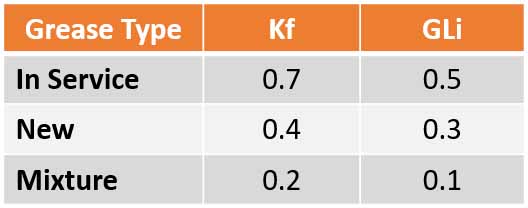
This case reflects one of the biggest problems when determining grease compatibility. Compatibility does not depend solely on the type of thickener.
The characteristics of the oil and additives also need to be analyzed and their affinity determined. In this case, the reaction mechanism was as follows:
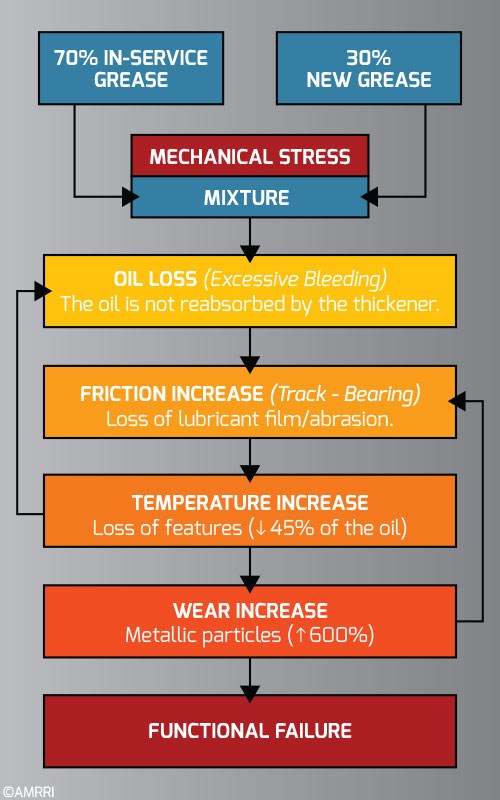
Once the grease has lost some of the base oil (and the dissolved additives), the temperature takes care of the rest. As a result, the inside of the bearing contains a semi-solid paste with a crystallized texture, which is mainly burned thickener.
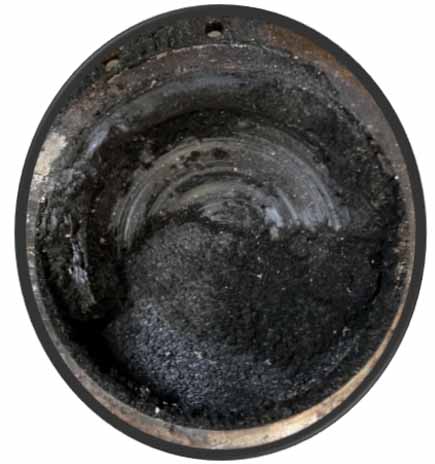
Grease Thickener in Dismounted Bearing
Should Greases Be Mixed or Not?
Consider the following when trying to decide whether or not to mix grease:
It is essential to remember that the information available on the web is not entirely reliable or does not apply to all cases. This does not only happen with the subject of greases.
A lab should carry out the compatibility analysis with enough expertise in analyzing and interpreting the results. There is a big difference between having the results and defining the behavior of the mixture in the bearing, which requires particular knowledge.
A compatibility test should include at least the following:
- Determination of type and concentration of additives
- Determination of the base oil
- Consistency
- Rheological determination
- Tribological tests
Periodically evaluate the in-service grease. It is necessary to know how they behave and if they provide the lubrication the bearing needs.
Once a new grease has been added to the bearing, increase sampling and inspection frequency (at least half of the initial frequency).
A grease consumption increase is usually an indicator of problems; it does not necessarily have to coincide with an increase in bearing temperature.
Only perform a grease consolidation after first determining the pros and cons of mixing lubricants and basing your decision on lab analysis. It is very convenient to have one or two greases on site but evaluate the risk first.
Use at least two PdM tools to determine the bearing lubrication condition.
These recommendations can mean the difference between having a problem and having had a problem. Remember Jack, the Apollo 13 astronaut.
[1] https://www.lubesngreases.com/lubereport-americas/5_31/afton-declares-force-majeure/



